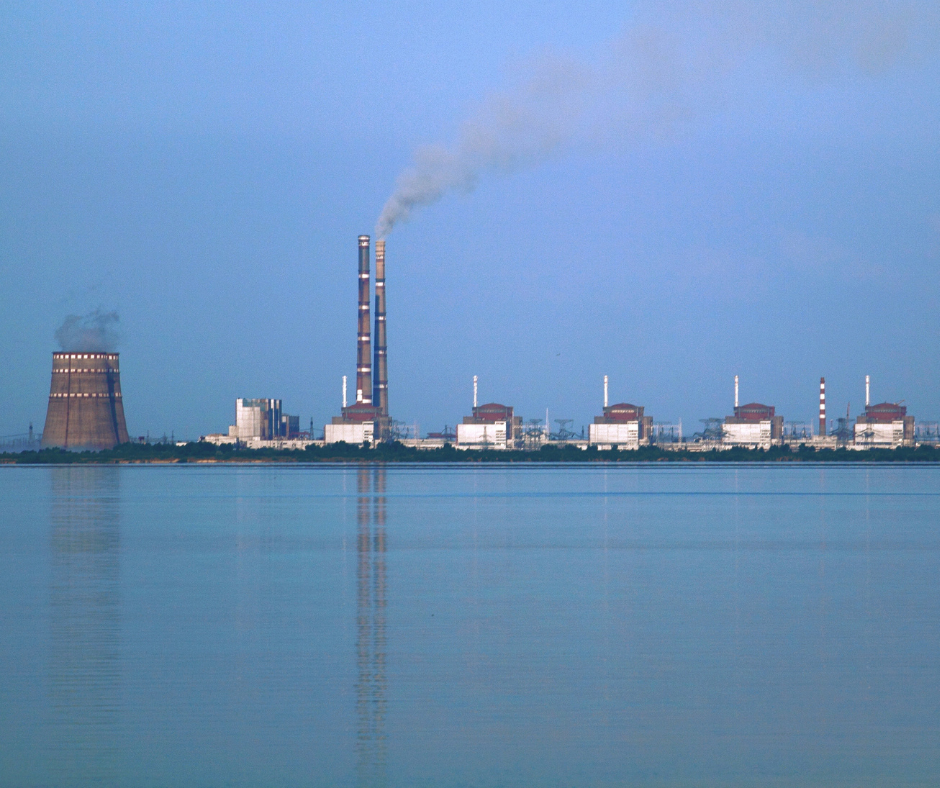The article tells about the seizure of the Zaporizhzhya NPP, what russians are going to do with the station, and how the IAEA is reacting.
For the first time in history, humanity is witnessing nuclear terrorism. In early March, russian invaders shelled Zaporizhzhia Nuclear Power Plant. As a result, massive flames have occurred. Firefighters weren’t able to take the situation under control because of intense shelling. Later, Energoatom reported that the building of one of the nuclear reactors had been damaged. It could lead to tragic consequences.
Since then, russians have used the power plant as a military base. They have repeatedly blown up ammunition near the first nuclear reactor and the ruins of the training center. On the anniversary of the Chernobyl disaster, April 26, enemy’s missiles were recorded flying over ZNPP reactors.
What is the Zaporizhzhia Nuclear Power Plant?
Zaporizhzhya Nuclear Power Plant is the largest in Europe, located near the city of Energodar in the Zaporizhzhia Oblast. ZNPP has six nuclear reactors, each with a capacity of 1 million kW. The first nuclear reactor of the station was put into operation in 1984, the last — in 1995. Five of the plant’s six reactors were extended for another ten years: the first was extended until 2025, the second until 2026, the third until 2027, the fourth until 2028, and the fifth until 2030.
The station has a “dry” spent nuclear fuel storage facility, which was put into operation in 2001. Spent fuel is stored in 380 containers. It is predicted that the repository will ensure the storage of spent fuel cartridges for the next 50 years, which will be removed from the reactors throughout the life of the station. Spent fuel is much more dangerous than regular nuclear fuel. It can be used in the creation of the so-called “dirty bomb” — a radiological weapon that combines radioactive materials with conventional explosives.
“A dirty atomic bomb explodes due to an ordinary explosive, not an atomic chain reaction. But this common explosion spreads radioactive materials, making the area or certain objects uninhabitable. Russian criminals who rob jewelry and even steal Ukrainians’ washing machines, can extract spent fuel stored at ZNPP and scatter it over Ukrainian cities,” says Andriy Martynyuk, executive director of Ecoclub.
After the Fukushima disaster in 2011, the world had to reconsider the safety of nuclear power plants. Risk and safety assessments (stress tests) were conducted at all European NPPs. The tests measured the ability of nuclear facilities to withstand damage from earthquakes, floods, terrorist attacks or collisions with aircraft. Based on the results, further security measures were formulated. In particular, it was recommended for Zaporizhzhya NPP to modernize backup diesel engines and provide them with modern electronic control systems by 2017.
What is the current situation?
As of May 9, ZNPP is still under the control of russian army and “Rosatom”. Nevertheless, the station is run by Ukrainian staff. “Energoatom” still keeps in touch with the plant and formally continues to be responsible for nuclear and radiation safety as an operator, although this raises many questions:
“We cannot be held responsible for all the guarantees we have as an operator. In particular, for nuclear material at the station. The facility’s physical security is violated due to the Russian invaders, who control the situation. The ZNPP personnel must coordinate all their actions with the commander of the russian troops,” said Petro Kotin, head of “Energoatom” on UA: First TV channel.
As of March 14, eleven “Rosatom” representatives were present at the Zaporizhzhya NPP. Earlier, “Energoatom” published their names. There are now more than 500 russian troops and heavy equipment at the station. Eight specialists from “Rosenergoatom,” — a division of Russia’s state nuclear company “Rosatom” — are also at the station. They demand daily reports from the plant’s management on “confidential issues” about the administration and management, maintenance and repair, protection of the station and access control, as well as the management of nuclear fuel, spent fuel, and radioactive waste.
Nevertheless, the press secretary of “Energoatom” stated that “the current capacity of ZNPP nuclear reactors is quite sufficient to support the population`s needs and the operation of industrial facilities.”
What is the danger?
Russian artillery has damaged the building of the first nuclear reactor. The Minister of Foreign Affairs of Ukraine said that shelling of the NPP could lead to a disaster ten times worse than Chernobyl.
“Rosatom” officials are putting enormous danger to employees. Workers have to coordinate all technical plans with the invaders; because of it, personnel cannot be fully responsible for the nuclear safety of facilities.
“Russian experts claim that they came to help Ukrainians manage the station. Ukrainian specialists do not need such help. Russian personnel may not be aware of the nuances of ZNPP’s work and procedures. For example, NPP is using American nuclear fuel. I assume that the presence of American fuel at the nuclear power plant attracted the attention of russian nuclear officials because they had never had an opportunity to study it before. As long as the Russian military is at the station, Energoatom is unable to carry out real control of the nuclear facility, and the danger is growing. It is important to create a no-fly zone over all Ukrainian nuclear power plants and regain control over all nuclear facilities,” said Olga Lyashchuk, coordinator of Ecoclub’s projects.
Since November 2021, four nuclear reactors of ZNPP use nuclear fuel made by an American corporation “Westinghouse.” Until 2016 all ZNPP nuclear reactors were using russian-made fuel.
“ZNPP is placed on the bank of the Dnipro river. The Dnieper flows into the Black Sea, so it could lead to a global catastrophe”, warned Dmytro Humeniuk, head of the safety analysis department of the State Scientific and Technical Center for Nuclear and Radiation Safety.
What is an IAEA doing?
IAEA sets the standards for nuclear safety and environmental protection and also provides technical support for the member countries. The agency has 164 member countries. The general director of the agency is Argentian Rafael Grossi, who has 6 deputies. One of the deputies is the russian Mikhail Chudakov. IAEA hasn’t condemned russian invasion. They call the biggest war in Europe since WW2 “the conflict.”
Ukraine constantly informs the IAEA about the situation at the Ukrainian nuclear facilities, including the Zaporizhzhya NPP, which operates under occupation. On May 4, Rafael Grossi and Oleh Korikov, State Nuclear Regulatory Inspectorate of Ukraine, met at the IAEA headquarters in Vienna. They discussed the situation regarding the capture of ZNPP and possible ways to liberate the station.
“We took stock of progress in our nuclear safety and security assistance to Ukraine, and spoke on Zaporizhia NPP, where the IAEA is ready to fulfill its indispensable role”, Grossi said on Twitter.
The same day Grossi met with Alexey Likhachev — head of the “Rosatom”. They were talking about the seizure of ZNPP by russains. Details and results of the meeting have not been announced.
IAEA ignores the call for the de-occupation of Ukrainian nuclear facilities. Their only reaction is deeply concerned tweets. During a visit to Ukraine on March 31, Rafael Grossi was asked about how he could help liberate Ukrainian nuclear facilities. He replied:
“The IAEA is a technical organization and does not participate in political negotiations.”
Where to check the radiation level?
Information on radiation levels can be found on Saveecobot. It is an online system that also provides information on air pollution levels, including harmful substances. Information on the radiation level in the Rivne region is published by the Rivne Regional Center for Hydrometeorology on the official Facebook page.











